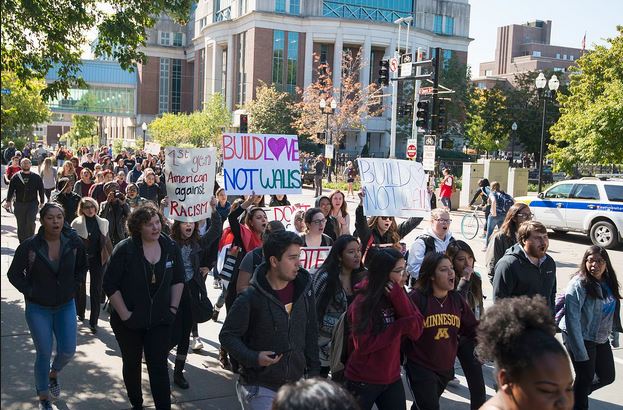Trump has threatened to cut-off Federal aid to the University of California, Berkeley, after protests and property destruction on and around the campus blocked right-wing provocateur Milo Yiannopoulos from speaking.
The University of California system “receives billions of dollars from the federal government to fund a variety of programs, notably research, student aid and healthcare programs.”
Predictably, liberals claimed that Trump’s proposal makes no sense. But is Trump really so wrong?
Indeed, what if federal subsidies were causing a reduction of free speech on campuses? What if university administrators are using their positions to restrict the free speech rights of students?
Law professor Glenn Reynolds in his book The Higher Education Bubble explains how federal aid to higher education, including guaranteed student loans, has increased the price of tuition. More loans create more demand, which increases the price. Perversely subsidies to make college more affordable have made college more unaffordable.
Reynolds cites statistics by economist Mark Perry showing that from 1978-2011 tuition grew “at an annual growth rate of 7.45 percent a year” and “has vastly both outstripped the consumer price index and health care prices.”
From 1995 to 2015, tuition and fees at flagship state universities increased a staggering 296 percent.
Rather than spending their new revenues on education, administrators at colleges and universities have, you guessed it, hired more administrators.
Over the past 25 years the number of administrative positions at American universities and colleges has more than doubled “vastly outpacing the growth in the number of students or faculty.”
Heather McDonald of the Manhattan Institute reports on how the University of California system slashed academic programs in fields such as computer engineering and literature, while it found money for an enormous “diversity machine” which includes a “vice chancellor for equity, diversity, and inclusion” as well as a “chief diversity officer, the director of development for diversity initiatives, the Office of Academic Diversity and Equal Opportunity, the Committee on Gender Identity and Sexual Orientation Issues, the Committee on the Status of Women, the Campus Council on Climate, Culture and Inclusion, the Diversity Council, and the directors of the Cross-Cultural Center, the Lesbian Gay Bisexual Transgender Resource Center, and the Women’s Center.”
What do those largely unaccountable administrators do? Yale Professor David Gelernter observes that colleges “spend more every year to finance their growing administrations and pass the bill to students, while indulging their penchant for being sinister and ludicrous at the same time.”
“Sinister and ludicrous?” Is that exaggeration?
Of course, not all college administrators are useless and some, such as those at the University of Chicago, thoughtfully protect rather than violate rights. However, there is a law of economics—what you subsidize, you get more of. More subsidies mean more administrators who violate rights.
The nonpartisan Foundation for Individual Rights in Education (FIRE) rates colleges on how well they protect individual rights, including the right of free speech. In 2016, only 5 percent of the 440 schools reviewed by FIRE received it’s “green light” rating, indicating a clean bill of health. Of the 440 schools, almost 50 percent received a red light rating “for clearly and substantially restricting student and faculty speech on campus.” The rest were in the yellow light category. Schools earn the yellow designation with “policies that could be interpreted to suppress protected speech or policies that, while clearly restricting freedom of speech, restrict only narrow categories of speech.”
Last fall, 111 large public colleges and universities, including Clemson University, the University of Oregon, the University of Texas at Austin, the University of Georgia, and the University of Kansas, received letters from FIRE informing them of their red light status.
As FIRE points out, “since public colleges and universities are legally bound to protect their students’ First Amendment rights” the fact that 94% received a red or yellow light is “unacceptable.”
FIRE draws the link between the suppression of free speech and the time period during which the administrative class in colleges began to explode: “Speech codes—university regulations prohibiting expression that would be constitutionally protected in society at large—gained popularity with college administrators in the 1980s and 1990s.”
We can ask these questions: Are taxpayers, students, and parents subsidizing the violation of fundamental constitutional rights? If so, why should they?
—
Barry Brownstein is professor emeritus of economics and leadership at the University of Baltimore. He is the author of The Inner-Work of Leadership. He delivers leadership workshops to organizations and blogs at BarryBrownstein.com, and Giving up Control.
[Image Credit: By Fibonacci Blue from Minnesota, USA (Campus protest march against hate speech) [CC BY 2.0 (http://creativecommons.org/licenses/by/2.0)], via Wikimedia Commons]
















Leave a Comment
Your email address will not be published. Required fields are marked with *